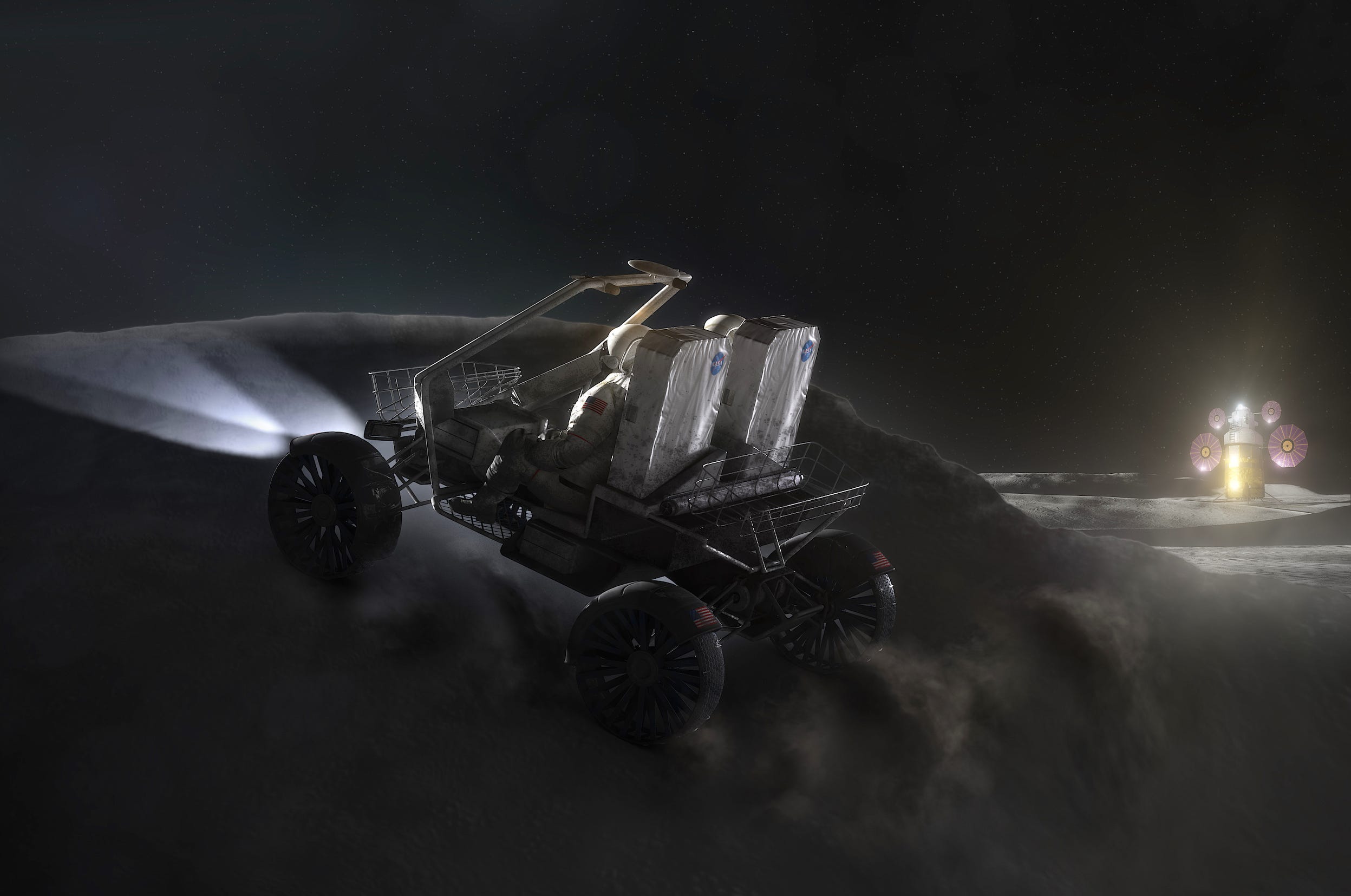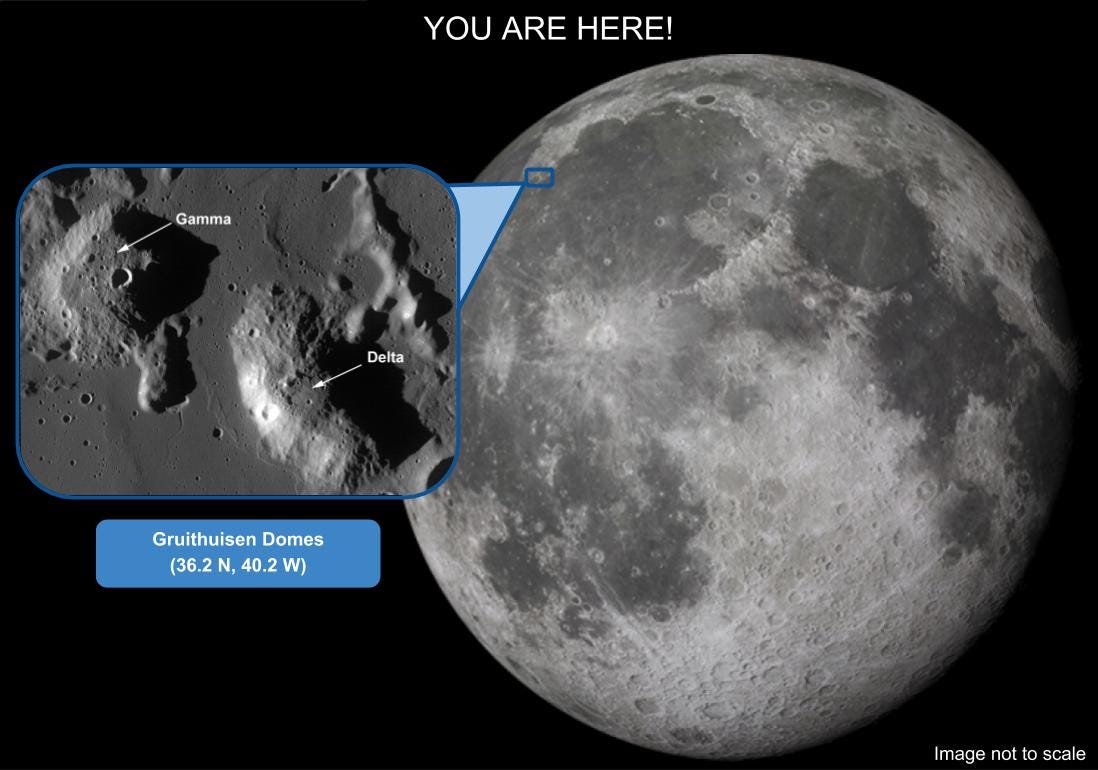Moon Monday Issue #43
NASA details plans for its next-generation rover to drive astronauts around the Moon, seeks science instruments for a mission to a unique volcanic site on the Moon, and more lunar developments.
I’m not keeping well (non-nominal?) so this issue of Moon Monday may not be as refined as the other ones. However, all major lunar exploration and science updates of the week have been covered, with the lead story being the fascinating new rover RFI from NASA that I didn’t see many publications cover, or with key new details about its landing and more.
Highlight
NASA has revealed more details on its plan to purchase a commercial rover for its Artemis astronauts to drive on the Moon later this decade. Before it solicits proposals for the same, NASA has laid out what capabilities it wants this Lunar Terrain Vehicle (LTV) to have, and is asking U.S. companies for their input by October 1, including how best to achieve those capabilities. Since NASA is going back to the Moon with the intent to stay this time, the LTV will be far more capable than the rover used by Apollo astronauts, and more sophisticated than even the current crop of Mars rovers.

- The LTV will be an unenclosed, all-electric rover that two suited astronauts can drive on the Moon for up to 20 kilometers without the rover needing a recharge.
- Instead of each mission carrying its own rover like Apollo, the LTV will be used across multiple Artemis missions, and work for at least 10 years. This means the LTV must survive the extreme night-time temperatures at the Moon’s south pole every month, which for it can last from a few hours up to at least 85 hours.
- The LTV should be able to traverse +/- 20 degrees slopes, and in general navigate the a challenging terrain at the Moon’s south pole, including spending up to 2 hours in permanently shadowed regions. NASA would also like if the rover has at least some autonomous capabilities.
- When astronauts on missions aren’t using the LTV, which would be about 11 months every year initially, the rover will be remotely operated by people at the NASA-led Gateway lunar station or from Earth, wherein it can transport up to 800 kilograms of cargo, science instruments and technology demonstrators between desired points on the Moon.
Despite its capabilities, NASA wants the vehicle’s mass and cost to be as low as possible, since it will be launched to the Moon on a commercial lander as part of the agency’s CLPS program. NASA wants the LTV on the Moon in 2027, meaning it will be used after at least the first Artemis landing mission if not more.
NASA will use feedback from the U.S. industry from this Request for Information to better the agency’s actual commercial solicitation later, wherein the companies will propose their best rover designs. We already know one of the bids will be from Lockheed Martin and General Motors, who in May revealed that they’re developing an autonomous lunar rover.
It should be noted that the LTV is just one of the two rover types part of NASA’s Artemis Base Camp, which aims to ready the infrastructure for at least a few astronauts to live long-term on the Moon. The other rover is a pressurized, habitable one, which would enable astronauts to explore the Moon’s south pole up to 45 days. NASA will presumably solicit proposals for this at a later stage.
P.S. NASA also made a cool video ad for the LTV.
Exploration
NASA hopes to launch its first Artemis mission to send an uncrewed Orion spacecraft around the Moon by end of year, and is sticking to that date in all official channels. However, Ars Technica reports that a source tells them the mission will not launch before (northern hemisphere) spring 2022 at the earliest. NASA is already running about two months behind internal targets for integrating the SLS rocket for the mission, and cites COVID-19 having been a key delay factor.

Meanwhile, NASA is inviting a limited number of media to visit the facilities where the rocket and spacecraft and being integrated for launch, and to interact with NASA experts and contractors to better understand the mission. Deadlines to apply are:
- September 10 for international media residing in the U.S.
- September 24 for U.S. media
Related: A good overview by NASA on the roles of different teams during the Artemis I mission.
Per Long Lehao, the chief designer of China’s very successful Long March family of rockets, China could modify its existing Long March 5 rocket to be able to land humans on the Moon by 2030 instead of waiting for the super heavy-lift Long March 9, which won’t be ready for operational flights by then. Lehao said one of these Long March 5 rockets would launch a lander into lunar orbit, and the second would send the crew to dock with it. The crew would then transfer to the lander, touchdown on the Moon's surface, and return to Earth after accomplishing the mission.
Andrew Jones, a journalists who tracks China’s space program told Ars Technica that while Lehao’s words don’t officially represent Chinese space policy, he is an influential figure, and that this is a good indication that China is at least thinking about such an accelerated plan to land humans on the Moon.
Science
NASA’s CLPS program to send science instruments to the Moon on commercial landers continues its enhanced science phase under the young PRISM initiative. After selecting science instruments to be launched on missions to the lunar swirl of Reiner Gamma and the Schrödinger crater on the Moon in 2024, NASA is now asking U.S scientists to propose science instrument suites for two more landed missions. The first mission will visit Gruithuisen Domes in 2025, and the second anywhere on the Moon’s south pole between 84-90 degrees latitude in Q4 2025 or Q1 2026. The proposals, which must achieve unique landing-region-specific scientific objectives, are due December 20. The selected instruments will be announced next year, followed by the commercial landers they will be on.

Visiting any of the two domes of Gruithuisen would greatly expand our knowledge of the Moon’s volcanic past. That is because the domes are made up of silicic material instead of basalt, the later of which is more common in the Moon’s volcanism. For the solicitation, NASA will fund instruments up to $40 million to study the region. The agency will be asking the yet-to-be-selected commercial lander provider, who will deliver the selected instruments, to also provide a rover capable of traveling up to 500 meters from the landing site. Scientists can propose up to 30 kilograms of instruments on the lander and up to 15 kilograms on the rover, or a hard cap of 50 kilograms of lander-only instruments.
NASA will fund instruments up to $20 million for the south polar mission, and their maximum mass is 30 kilograms. For the mission, NASA will also host an ESA-provided technology called PROSPECT, which includes a drill and sample handling system, spectrometers, and an oven to detect and study water and other volatile resources at the Moon’s south pole.
SpaceNews reports that NASA currently doesn’t plan to trade its Apollo lunar samples with the young samples returned by China’s Chang’e 5 mission to study the Moon’s (geologically) recent volcanism. At the annual meeting of the Lunar Exploration Analysis Group on August 31, NASA’s Chief Scientist Jim Green said that the U.S. Wolf Amendment restricts bilateral cooperation between NASA and Chinese organizations, and rules out any exchange of lunar samples between the two nations. However, other countries can apply to study the lunar samples.
Related: Check out NASA’s Lunar Sample Compendium, which is an online catalog of the Moon samples brought by NASA Apollo and Soviet Luna missions. It summarizes and references significant findings about each rock, and provides thin section photomicrographs, mineralogy and chemical data, photos of samples on the lunar surface, and more.
More Moon
NASA has released Artemis-themed educator guides. The Landing Humans on the Moon guide offers four activities to help middle-school students learn about the Moon and create a model of a human landing system for its surface. Other guides focus on other key mission concepts, such as transporting crew, understanding propulsion, living in lunar orbit, and more.
Dear reader, I’m publishing this one-of-a-kind Moon exploration newsletter for free, with no ads. And it will stay that way. If you like my work, your support will keep it going.
